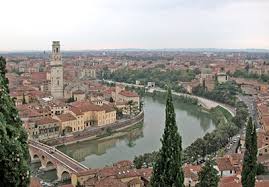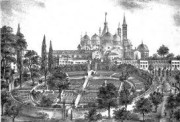Brief City’s History
In ancient times Verona was inhabited by Venetians, Cenomani Gauls (a Celtic people) and primordial Etruscan populations. The Roman Empire established a closer relationship with those populations around the third century before Christ. Romans, Gauls and Venetians joined in the building of the City near the banks of the Adige river, while on St. Peter’s hill a castrum for a Roman legion was built. In 49 BC Julius Caesar granted Verona the Roman citizenship, a town hall and an area of 3,700 square kilometers.In the Republican era of Roman Empire Verona became a base for its legions, grew up (surpassing the 25,000 inhabitants) and enriched. A big Arena was built for hosting shows for the citizens. Afterwards, the Ostrogoths conquered the City, later taken over by the Byzantines and then by Lombards. The important Lombard Duchy was finally defeated in 774 AD by Charlemagne. The Carolingian period began with the coronation of Charlemagne (800 AD) and the birth of the Holy Roman Empire. Verona was always loyal to the Emperor in the numerous wars with the Papacy burst after the year 1000 AD. In 1136 AD the Municipality was born, with the investiture of the Consuls. In the rural area the Guelfs (loyal to the Papacy) strengthened, while within the City the Ghibelline faction (loyal to the Empire), including the Montague family, famous for the Shakespeare’s drama “Romeo and Juliet”, did it. In 1181 AD Pope Lucius III ° established the Papal seat in Verona and remained there for 5 years; Lucio was then buried in the City Cathedral . In the next conclave Pope Urban III° was elected, who wishing to excommunicate the Emperor Frederick Barbarossa caused the reluctance of the Veronese people to such an extent that he decided to move the Papal headquarters in Ferrara. In 1223 AD the Ghibelline Ezzelino III ° da Romano took over. Ezzelino imprisoned many members of popular Guelph families and began to attack important Gueph Fiefs, and his power grew so much as to worry even the Emperor (his boss) and Pope, who captured and imprisoned him forever. The Della Scala family, Ghibelline, took power in Verona, turning it from Municipality to Lordship. The famous CanGrande Della Scala I ° ruled the City with great wisdom and became the Lord of many other Cities as Padua, Vicenza, Treviso, Bassano, Belluno, Monselice and Feltre. His successor, Mastino II ° Della Scala conquered Lucca too, extending the domains of Verona until the sea. The powerful Republic of Venice, worried by the rise of Verona, formed a League with other great Lordships of those times as the Estensi from Ferrara, the Carraresi from Padua, the Visconti of Milan and the Gonzaga from Mantua, and succeeded, in two battles,to defeat Verona. The City was granted to the Visconti family, then its control passed to the Carraresi family and finally was conquered by Venice, who ruled it from 1405 AD to 1501 AD. The powerful League of Cambrai (formed by the Papacy with the ‘Emperor, the King of France, the House of Aragona, the House of Este, the House of Gonzaga and the House of Savoia) attacked Venice and from 1509 AD to 1517 AD, Verona passed into the control the troops of Emperor Maximilian I°. Subsequently Verona came under the enlightened Venetian hegemony and experienced a long period of peace and prosperity, where splendid palaces and Churches were built. In 1630 AD, the population of Verona, reaching around 53,300 inhabitants, was decimated by the plague brought to Italy by German soldiers, dropped up to 20,700 inhabitants. In 1796 AD Verona was conquered by Napoleon Bonaparte, who, only a year later in 1797 AD, with the Treaty of Campo Formio, gave it up to Austrian Grand-Duchy, along with the Republic of Venice. The Congress of Vienna (1815 AD), marked the final conveyance of Verona to the Austrians. In 1866 AD, the Kingdom of Italy, led by the Savoy, attacked the Austrians in a war made of victories and defeats, after which, Veneto was annexed to the Kingdom of Italy.
The City
Togheter with Padua and Venice, Verona is the most important City of Veneto. The City has arisen over 2000 years ago on the banks of the Adige river, close to the Alps, and about 30 miles from the famous Garda Lake, and has a population of about 252,065 inhabitants. UNESCO World Heritage Site, Verona is a famous tourist destination, thanks to its important architecture and history. At the time of the Roman Empire, Verona was an important transportation junction, because here 4 well known consular roads intersect . During the centuries Verona has enriched and developed, becoming a beautiful City. Walking through its wonderful Old Town you can perceive the huge aristocracy and order of this place. Its palaces, streets, squares, monuments … everything is elegant, harmonious and well preserved. Verona is neither a city nor a village, and therefore it is a good compromise for those who long for life quality. The City of Verona is very rich in history. Its Churches, Palaces, Squares and gates, show the splendor of the various periods that one after the other have built it. The walls that have surrounded and protected it were built at first in Roman times, then bolstered in the period of the Scaliger Lordship (Della Scala family, then by the Venetian Republic, and finally by the Austrians in 1833 AD. Its Walls extend for more than nine kilometers and have within them: towers, ramparts, moats, gates and embankments. Here is a brief list and description of important monuments to see when you are in Verona.
Places to see
1. The Verona Arena: After the Coliseum and the Arena di Capua the Verona Arena is the third largest Roman amphitheater, it is very famous in Italy and in the whole World. When it was built it was located just outside the City walls, which are still partially present and visible, and it was used for the shows of the fights among gladiators. The term “Arena” means “sand” and it is hence derived from the sand that was placed on its floor. The construction of other outer City walls, which took place in 1100 AD, has put it within the Old Town, in the great Bra Square. In 1117 AD a great earthquake destroyed its outer ring; after the collapse, many blocks of decorated stone were recovered and subsequently used in the construction of some Romanesque Mansions of the Centre. In 1500 AD the Arena was restored and is still in excellent condition even now. On the inside it can accomodate up to 20,000 people and the acoustics are exceptional due to its elliptical shape, and for this reason it hosts an important opera season and many pop concerts.
2. ( Romeo and Juliet ) Juliet’s House: The ancient Roman maximus cardo became afterwards Cappello street, taking its name from a prominent family of merchants of spices of the times: the Dal Cappello family. Along this road within the historical center of Verona was located their home: a Tower house of the 1300s, then altered on some occasions , with the coat of arms depicting a hat, carved on the keystone of the entrance porch. This is, for all, the home of Juliet Capulet, the very famous Shakespeare’s Juliet (it seems likely that Shakespeare has never come into this house and also Romeo and Juliet are probably fictional characters. On both side of the entrance, pasted on two wallboard, there are thousands of notes left by lovers from around the World, essentially because this place is the symbol of all thwarted and unfortunate loves, and this poignant theme is always present in every age.
3. Della Scala’s Arks: Beside the enchanting Romanesque Church of Santa Maria Antica, built in the 600s AD, the powerful Della Scala family (in command of the City from 1277 AD to 1387 AD) built its Chapel where, close to the Della Scala’s dwellings and the Church, a burial ground was created, where the ” Arks “, the tombs of the powerful Lords of Verona, were placed. Real architectural jewels in the Gothic style. The first ones of them were simpler, in Romanesque style, then the later ones have become much more decorated. The most impressive Arks are those belonging to CanGrande della Scala, who died in 1329 AD, to his nephew Mastino II ( both of them enhanced with an equestrian statue put on their tops) and to his great-grandson Cansignorio. The statues put on the Arks are copies, the original ones are preserved in Castevecchio.
4. Castelvecchio: Castelvecchio, so-called because it became old when the Viscontean Castle was built (1398 AD), is the largest City military monument. It was built by CanGrande della Scala II°( brother of Cansignorio, from whom he was then murdered ) in 1354 AD. Designed by the Lordship as a secure fortress against any possible civil war within Verona, the castle has also a very beautiful fortified bridge. This impressive building has had its scope changed many times: it was at first a weapons warehouse, then the headquarters of the Academy of Military Engineering, then a refuge for rebels of the anti-French Veronese Easters, and finally Napoleonic barracks with the addition of a wing towards the river. Subsequently, the Castle, whose original towers have been destroyed by the French, was renovated several times and today houses a beautiful Museum of medieval, renaissance and modern Art (until 1700 AD). Its bridge is massive and its structure has made it able to withstand the various floods of the Adige river, with its three large arches and its big pentagonal-section shafts it was, for the Lord, a way of escape towards the external countryside and Germany.
5. The Roman Theatre: The Roman Theatre of Verona, a very ancient building dating back to the first century BC, is located at the foot of St. Peter’s hill, in front of the Adige River, between the two Roman bridges ( Pietra bridge and Postumius bridge ), of which Pietra bridge is the only still visible today. The stones of the Theater, over the centuries, were taken to be used in the construction of the great city Mansions, and subsequently also other buildings were built over this precious monument. The City had to wait about 2000 years to see these buildings demolished (with the exception of the Church of San Siro and Santa Libera) and the Theatre partially recovered. At theater, the Romans watched plays and dramas, a custom dating back to the Greek culture. Some precious artifacts recovered during the excavations are today preserved in Verona Archeological Museum ( housed in the former Jesuit monastery which is situated beside the Theatre ). Together with the Arena, the Theatre is still used for many events, including the Verona Jazz Festival and the Shakespearian Festival.
6. San Peter Castle: The St. Peter hill, which stands in front of the Adige river, behind the Roman Theatre, has housed, in ancient times, the dwellings of the early inhabitants of Verona. On its top a small temple was at first erected around 30 BC and then a little Church dedicated to Saint Peter, that’s why the hill is named after him . Gian Galeazzo Visconti, in 1398 AD, during the occupation of the city, erected a Castle which also incorporated the small Church. The Castle held up until 1801 AD, when it was destroyed, together with the Church, by the French of Napoleon Bonaparte. in 1851 AD the Austrians built a new Castle on the site where the medieval castle stood, for military use, in neo-Romanesque style, which is still perfectly preserved and can be visited.
7. Giuletta’s Grave: The former monastery of San Francesco al Corso has been converted around 1935 into a Museum. In the old cloister there is a staircase that leads to a crypt which houses the grave of Juliet and where, according to the Shakespearian legend both her body and that of her lover Romeo were brought. In other monastery areas and within the Church are preserved several medieval and Renaissance frescoes cycles, as well as sculptures from nineteenth century (Museum of frescoes ” G.B. Cavalcaselle ” )
8. Lamberti’s Tower: Lamberti’s Tower dates back at 1172 dC. Around this tall tower, raised up again and again reaching an height of 83 meters, an important building was erected a few years later: the Municipality Building. The tower base, built during the Roman period, is made with tuff stone and brick; the central part, added in later centuries, is made of terracotta tiles, while the top, where there is an octagonal white-stone belfry, with the emblems of both Venetian Podestà and Captain, dates back to the prosperous period of the Venetian domination (mid-1400 AD). The clock placed on the tower dates back to 1700 AD. The two bells placed in the belfry in 1295 AD enunciated town meetings ( the first ) and dangerous situations ( the second ). The tower that had in the past a defensive function and as a prison, was restored in 2007 and is currently part of a large museum complex.






